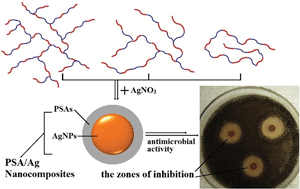The effect of a branched architecture on the antimicrobial activity of poly(sulfone amines) and poly(sulfone amine)/silver nanocomposites†
Abstract
The antimicrobial activity of a series of cationic poly(sulfone

* Corresponding authors
a
School of Chemistry and Chemical Engineering, State Key Laboratory of Metal Matrix Composites, Shanghai Jiao Tong University, 800 Dongchuan Road, Shanghai 200240, P. R. China
E-mail:
xyzhu@sjtu.edu.cn, dyyan@sjtu.edu.cn
Fax: +86-21-34205722
Tel: +86-21-34205699
b Key Laboratory of Ion Beam Bioengineering, Chinese Academy of Sciences, P.O. Box 1138, Hefei, Anhui 230031, P. R. China
c Instrumental Analysis Center, Shanghai Jiao Tong University, 800 Dongchuan Road, Shanghai 200240, P. R. China
The antimicrobial activity of a series of cationic poly(sulfone

 Please wait while we load your content...
Something went wrong. Try again?
Please wait while we load your content...
Something went wrong. Try again?
R. Wang, L. Wang, L. Zhou, Y. Su, F. Qiu, D. Wang, J. Wu, X. Zhu and D. Yan, J. Mater. Chem., 2012, 22, 15227 DOI: 10.1039/C2JM00122E
To request permission to reproduce material from this article, please go to the Copyright Clearance Center request page.
If you are an author contributing to an RSC publication, you do not need to request permission provided correct acknowledgement is given.
If you are the author of this article, you do not need to request permission to reproduce figures and diagrams provided correct acknowledgement is given. If you want to reproduce the whole article in a third-party publication (excluding your thesis/dissertation for which permission is not required) please go to the Copyright Clearance Center request page.
Read more about how to correctly acknowledge RSC content.
 Fetching data from CrossRef.
Fetching data from CrossRef.
This may take some time to load.
Loading related content
